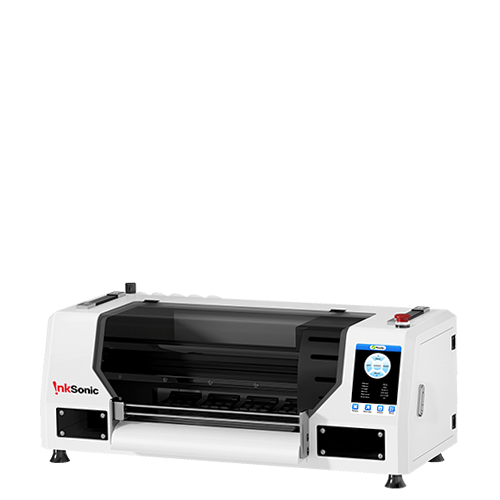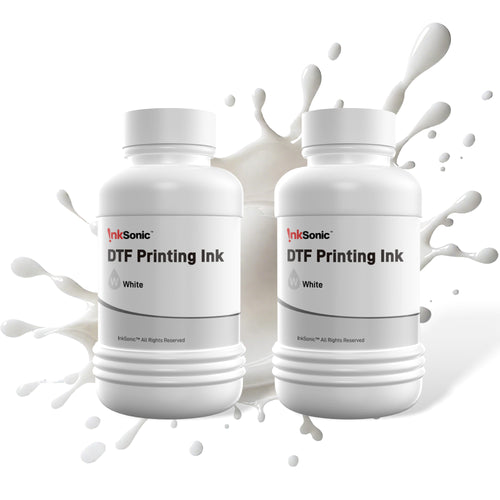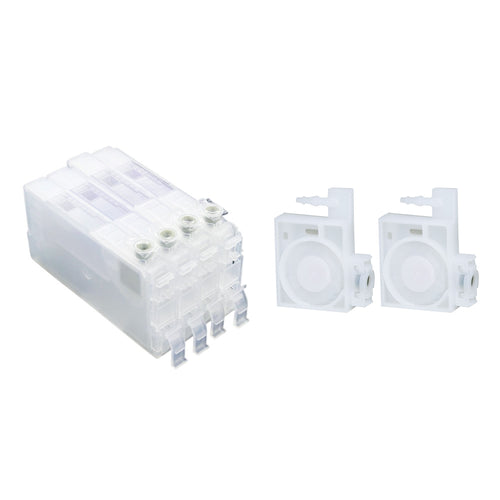What Is DTF Printing and How Does It Work?

DTF printing or direct-to-film printing is a process wherein the design is printed onto a special film using a DTF printer. Once printed, an adhesive is applied to the layout and transferred to the fabric using a heat press. The result? A vibrant, detailed print that looks awesome!
To do this trick, you'll need equipment. First is, of course, the printer itself. You'll also need a heat press to transfer the design to the textile and additional supplies like film, adhesive powder, and ink. With proper setup, you'll have your design come alive.
Why a Direct-to-Film Printer Is the Best

Direct-to-film printing is stealing the spotlight in garment printing. Here's why it crushes its competition:
It Works on Almost Any Fabric
Whether cotton, polyester, or scarf, DTF can handle it! Some printing methods are picky about materials, but DTF works on all kinds of fabrics—even dark colors.
Highly Durable Prints
With a DTF print, you won't have to deal with cracked or faded designs after a couple of washes. The prints are built to last, so you can rock your customized shirt confidently, knowing the design will look fresh for a long time.
A Design That Pops
This printing method uses more colors than other printers, bringing your design to life. It's like printing a high-definition picture. Every detail pops and comes alive in bright, vibrant colors.
Handles Complex Designs
Do you have a layout in mind with lots of intricate details, shadows, or fades? No worries—DTF can handle it! It can print even the most complex designs flawlessly, allowing you to use your creative juice without boundaries.
Cost-effective for Small Business Owners and Hobbyists
Whether you're starting a small clothing line or want to print some cool shirts for yourself, a DTF printer is an excellent choice. Compared to other printing solutions, this one doesn't require much money. It's also ideal for shorter printing runs, making it a perfect choice for those getting started.
Comparing DTF Printers to Other Old-School Printing Solutions
So, how does a DTF printer go against traditional printing methods? Let's take a closer look.
DTF vs. DTG

DTG, or direct-to-garment printing, involves spraying the design directly onto the fabric; hence, the name. It's perfect for light-colored shirts and layouts with simple color palettes. However, DTF printing has the upper hand for the following reasons:
- Fabric Limitations – DTG printers struggle to create bright, vivid designs on dark garments. The ink may appear a little dull because the dark-colored material absorbs it. This will never be an issue with DTF prints. DTF uses white ink that acts like a canvas, making the colors pop on light and dark textiles.
- Color Vibrancy – Direct-to-fabric printers create more vibrant prints than DTG printers, especially when printing complex designs with many colors. DTF has a broader color range, allowing you to reproduce your artwork accurately.
- The Feel Factor – Designs made by DTG printers can sometimes feel stiff or heavy as the ink soaks into the fibers. Meanwhile, those created by DTF printing feel soft and light. That's because the design is transferred onto the garment, keeping the fabric's texture.
DTF vs. Screen Printing

Screen printing is a classic method. It's great for creating simple designs in large quantities. However, it has some limits compared to direct-to-fabric printing.
DTF vs. Sublimation

Sublimation is a printing process that infuses special ink into the polyester fibers by turning it into a gas with heat. It creates durable prints, but it has a major drawback. It only works well on polyester and polyester-blend fabrics with light colors. A DTF printer is a perfect choice if you want to work on cotton, silk, or other fabrics.
Industries That Can Use DTF Printing

DTF printing is incredibly adaptable, making it a valuable tool for various businesses and projects. Here are some key industries where DTF shines:
Sportswear and Team Apparel
Customize jerseys, shorts, and other team gear with DTF printing. It handles stretchy, technical fabrics like a champ while delivering vibrant colors and long-lasting prints that can endure the wear and tear of sports. Easily personalize gear with player names and numbers!
Promotional Products
DTF printing allows you to brand promotional items like tote bags, hats, water bottles, and other merchandise. Expand your product offerings and increase brand visibility with durable custom prints.
On-Demand Printing and Small Fashion Brands
DTF's efficiency for small-batch printing is a lifesaver for on-demand sellers and those launching their own clothing lines. You can quickly fulfill orders, test new designs without massive upfront costs, and expand your product line.
Workwear
Outfit your employees in gear that represents your brand perfectly. DTF can customize workwear like uniforms, safety vests, and jackets. Its durability means your prints will withstand frequent use and washing.
Thinking About Getting a DTF Printer?

Before you jump in and buy a DTF printer, let's talk about some things to consider:
Initial Investment
DTF printers require an upfront investment, but the good news is they tend to be more budget-friendly than setting up other printing methods like screen printing. The exact cost of a DTF printer can vary depending on several factors, including the brand, size, and features offered. Generally, you can find DTF printers at various price points that suit your needs.
On top of the printer itself, you'll also need to factor in the cost of ongoing supplies. These essential supplies include:
- Special DTF Ink – Unlike regular printer ink, DTF uses specialized inks formulated to work effectively on the transfer film.
- DTF Transfer Film – This is the special film your design will be printed onto. It acts as a medium for transferring the design from the printer to the fabric.
- DTF Adhesive Powder – This plays a crucial role in the process. The powder works like glue, sticking the design printed on the film to the fabric after applying the heat press.
Ongoing Costs
The ongoing costs associated with DTF printing depend on how frequently you print. Here's a closer look at the expenses you'll encounter:
- Ink Consumption – The amount of ink you use will vary depending on the size and complexity of your designs. Designs with large areas of solid color or intricate details will naturally use more ink. However, DTF printing is generally considered ink-efficient, especially compared to methods like DTG.
- Film and Powder Usage – Similar to ink usage, the amount of film and powder you use is directly linked to the size of your prints. Larger designs require more film and powder, while smaller prints use less.
While there are ongoing costs to consider, DTF printing is a very cost-effective solution, particularly for smaller printing runs and businesses that require printing on different fabrics.
Choosing a Printer
With many DTF printers available on the market, selecting the right one boils down to understanding your specific printing needs. Here are some key factors to consider when choosing your DTF printer:
- Print Speed – A printer with a fast print speed is essential if you anticipate high-volume printing or require quick turnaround times. Look for printers with high dots per inch (DPI) for sharper results at faster printing speeds.
- Print Area – Consider the maximum size of the designs you plan to print regularly. Choose a printer with a print area that can comfortably accommodate your typical designs to avoid limitations.
- Features – Some DTF printers offer additional features that streamline your workflow and enhance your printing experience. Depending on your specific needs and budget, look for features like automatic powder shaking systems, built-in curing units, or white ink capabilities.
Is DTF Printing for You?
If you want a printing solution that produces high-quality prints, is versatile, and is easy to use, a DTF printer is the way to go. It revolutionizes garment printing and empowers small businesses, creatives, and hobbyists to make their designs come alive with incredible ease and vibrancy.
So, what are you waiting for? Start using a DTF printer and turn your custom apparel dreams into reality!
































